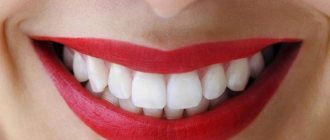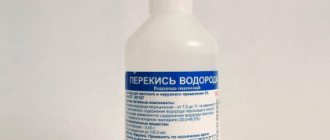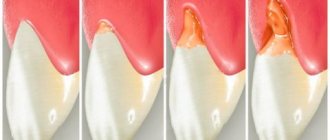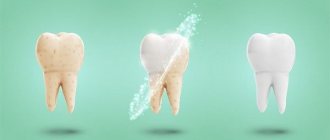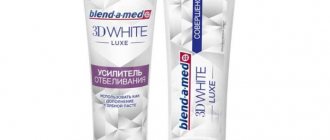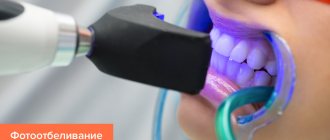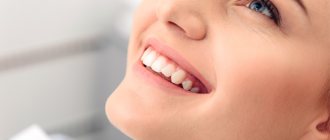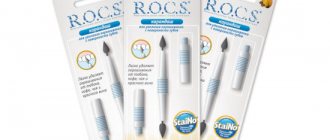Author of the article:
Soldatova Lyudmila Nikolaevna
Candidate of Medical Sciences, Professor of the Department of Clinical Dentistry of the St. Petersburg Medical and Social Institute, Chief Physician of the Alfa-Dent Dental Clinic, St. Petersburg
Today, there are many ways to whiten teeth in dentistry. Anyone who wants to get a delightful Hollywood smile will definitely find the most convenient and affordable option for themselves. You can change the color of your teeth a couple of shades to a healthy shade with professional cleaning, or you can achieve a snow-white smile with more serious cosmetic procedures. It all depends on your taste, desires and health. In any case, you can easily find the best method with the help of your dentist.
It must be remembered that whitening is a serious procedure that does not always have a positive effect on dental health. Therefore, it is important to take the choice of method and subsequent care seriously.
Let's talk about the differences, pros and cons of in-office whitening methods to help you navigate their diversity.
Types of teeth whitening in dentistry
Professional teeth whitening involves performing procedures in a dental office and under the direct supervision of a specialist. In this case, mechanical or chemical effects may be exerted on the tooth enamel. The effectiveness of the latter can be enhanced by the penetrating ability of ultrasound, laser or light, which act as an activator and conductor for the reagent that penetrates deep into the enamel.
Today there are a number of popular whitening methods, each of which has its own advantages and disadvantages. Their descriptions will help you give preference to one or another procedure.
Contraindications and recommendations
The enamel is subject to serious chemical exposure, so only those who do not have dental problems are allowed to undergo the procedure. Contraindications to bleaching are inflammation in soft tissues and foci of caries - all these pathological phenomena must first be eliminated. Excessive plaque and deposits can also become an obstacle to the procedure, so you should undergo a professional procedure about 2 weeks in advance. hygiene to prepare your smile for a radical transformation. Among other contraindications, experts highlight age under 16 years, pregnancy and breastfeeding, the presence of extensive fillings, crowns and bridges that fall into the smile zone, as well as pronounced dental anomalies that impede the quality of the procedure.
The procedure is not recommended for pregnant women
Only whitening carried out in the dentist’s office, that is, under his close supervision and control, is considered safe. When using home methods, less concentrated formulations are used, but they should be handled with extreme caution so as not to cause problems with the enamel or pulp injury. Before this, you must undergo an examination by a dentist and find out the current condition of the dental tissues.
So, the safest and most effective way is to use a laser as an activator of the active components of the lightening gel. In second place is photo bleaching, followed by chemical and home bleaching. Ultrasonic cleaning and Air Flow sandblasting are not whitening methods, but are much safer and healthier dental care procedures. As for the preservation of the achieved effect, much depends on the patient. It is better to give up coffee and strong tea, quit smoking, avoid coloring products and pay close attention to hygiene. Only such a comprehensive and responsible approach to oral care will allow you to enjoy a dazzling smile for as long as possible.
Photobleaching
One of the “youngest” whitening methods. During its use, a special whitening gel is applied to the visible surface of the teeth, with a minimum concentration of hydrogen peroxide, which, under the direct influence of light emitted by a halogen lamp, is activated and penetrates deep into the enamel, while breaking down its pigment plaque. This procedure is often called ZOOM whitening, since the ZOOM-4 series device can be used for it. You can sign up for a whitening procedure using the ZOOM-4 device on our website
Advantages
- Quick visible effect.
- Suitable for patients with sensitive tooth enamel.
- If you follow the dentist's recommendations, the effect lasts up to 2 years.
Flaws
- The duration of the procedure is 1.5 – 2 hours in the dentist’s chair.
- Unpleasant taste in the mouth after the procedure.
- There may be an effect of “unnatural whiteness” of teeth, with a blue tint.
Comments
Which professional method can still be considered the best?
Bogdan (10/11/2020 at 11:14 pm) Reply to comment
- It all depends on the clinical situation, the patient’s expectations and his financial capabilities.
Editorial staff of the portal UltraSmile.ru (10/14/2020 at 09:25) Reply to comment
I just have very sensitive teeth. I had it cleaned at the clinic, but it didn’t really help change the shade. I want more whitening effect...
Arina (10.30.2020 at 15:45) Reply to comment
- Dear Arina, perhaps you better consider microprosthetics, when the enamel of the teeth is covered with thin overlays made of ceramic, composite or zirconium dioxide. Such overlays can be snow-white at the request of the patient. They will not only give your teeth the desired level of whiteness, but will also hide minor defects (cracks and chips, old fillings, crevices). They will also protect sensitive enamel from external factors, prevent its destruction, and help reduce the level of discomfort from hard, cold, hot and sour foods.
Editorial staff of the portal UltraSmile.ru (03.11.2020 at 09:17) Reply to comment
Write your comment Cancel reply
Air Flow
This is a mechanical cleaning of enamel that effectively removes plaque and hard deposits (tartar) from the surface of teeth. To carry it out, Air flow sandblasting equipment is used, which supplies the enamel surface with a high-pressure stream consisting of water, an abrasive substance and air. Common soda crystals are used as an abrasive, destroying dental plaque and polishing enamel. Learn more about Air Flow teeth brushing.
Advantages
- During the procedure, tartar is removed, a common cause of caries.
- Ability to clean hard-to-reach places.
Flaws
- Lightening by only 2 - 3 tones.
- During the procedure, patients with sensitive enamel experience pain.
Why do teeth turn yellow?
There are many methods of whitening; it is recommended to decide which one to choose together with your dentist.
The doctor will be able to identify the cause of the color change and select a treatment method that is effective in a particular case. To effectively whiten your incisors, it is recommended to first determine why they are yellow. Healthy teeth are not snow-white by themselves; the outer layer naturally has a milky or beige tint, which is the physiological norm. In some people, the pigment is a little brighter, causing the smile to appear yellowish. The reason is the high concentration of minerals that make the incisors strong.
If the incisors themselves are snow-white and matte, this is a sign of negative changes in the composition of the enamel. Such teeth can soon crumble and they are susceptible to caries and are easily damaged by physical impact.
A yellow tint does not always indicate oral health. If a person has naturally milky incisors, but after a few years they have turned very yellow, the reason may be the following:
- consumption of coloring foods in large quantities - coffee, tea, bright berries, food with dyes;
- smoking, including hookah;
- the presence of tartar and plaque due to insufficient hygiene;
- age-related changes in enamel color;
- pathologies of the oral cavity.
The smile turns yellow in older people, this is due to changes in the outer layer, it becomes porous and dyes penetrate well inside.
Chemical bleaching
The name of the method speaks for itself and involves applying a special chemical based on hydrogen peroxide to the visible surface of the teeth. Penetrating deep into the enamel, it destroys pigment molecules, and teeth become 4 to 10 shades lighter.
Advantages
- Quickly achieve the desired effect.
- A long-term result, which, if the recommendations are followed, can last for 1.5 years.
Flaws
- Tooth enamel becomes more sensitive.
- If the gums are poorly insulated during the procedure, they can get burned.
Read more about office techniques
Professional whitening at the dentist involves applying a concentrated gel based on hydrogen peroxide or carbamide to the surface of the front crowns. Next, the composition is illuminated with a laser beam, ultraviolet or LED lamp. Essentially, it is a catalyst that activates chemical processes aimed at discoloring hard tissues. Similar methods, with the exception of laser, are united by a common term - photobleaching. It also does not include chemical bleaching, which involves applying a brightening composition to the enamel without the use of any catalyst.
In-office whitening methods are the most effective
The components of the gel affect not only enamel, but also dentin, although only 20% of its organic substances1. If you do everything correctly and strictly follow the technique of performing the procedure, there will be no serious harm to healthy teeth. You should always remember to take precautions, since too much exposure to the gel can cause pulp burns and other serious consequences.
Now let’s talk in more detail about which teeth whitening is the safest and most effective.
Ultrasonic and Air-Flow sandblasting
Mechanical cleaning with special tools, ultrasound and sandblasting using Air-Flow technology are all ways to remove plaque and remove solid deposits. These techniques cannot be classified as bleaching, since they allow maximum restoration of the natural color. Under the influence of an ultrasonic scaler, hardened deposits are destroyed, while a powerful air-water jet immediately washes away contaminants, and the abrasive particles in its composition carefully polish the enamel. By the way, Air Flow is widely used, including as an independent method of gentle cleaning, but the best effect can only be achieved by combining these techniques and an integrated approach to professional cleaning. hygiene.
The photo shows the method of brushing teeth with the Air Flow system.
The cost of the procedure ranges around 5 thousand rubles.
Laser whitening
The procedure is performed in the dentist's office. The specialist applies a highly concentrated hydrogen peroxide-based brightening gel to the prepared surface and activates its active components using a laser beam. The doctor treats each tooth separately. The technique is considered the most effective and harmless; it allows you to brighten your smile by 10 shades or more. At the same time, the laser beam provides a targeted effect, which reduces the risk of thermal and chemical burns of the mucous membrane, dentin and pulp.
With the laser method, each tooth is processed separately
The cost of one session is approximately 20 thousand rubles.
Photo whitening – ZOOM and Amazing White
When photobleaching using ultraviolet or LED light, a composition based on hydrogen peroxide is usually used in a concentration of 30-35%. After applying the product to the enamel, it is illuminated with a special lamp - the duration of one session does not exceed half an hour. To achieve the desired effect, a maximum of 3 sessions can be carried out, but preferably with sufficient intervals between each other.
ZOOM technology allows you to brighten your smile by 8-10, and sometimes even 12 tones. At the same time, the lightening gel includes calcium phosphate, which provides additional strengthening of the enamel. The cost of the procedure varies within 25 thousand rubles.
The photo shows teeth whitening using the ZOOM system.
Amazing White is another effective photo-whitening system that helps brighten your smile by 7-10 shades with a guarantee of long-term results. When exposed to an LED lamp, the peroxide molecules break down into oxygen and water. Oxygen molecules make their way through the outer layer to the dentin and contribute to a change in its shade. For one session using Amazing White technology you will have to pay about 15 thousand rubles.
Chemical enamel brightening
This technique also involves applying a special activator gel to the surface of the front crowns, but does not involve the use of any additional catalysts in the form of light or a laser beam. The method is not as effective as those described above, but it is more gentle. Using this technology, you can make your smile 5-7 shades lighter.
The photo shows the method of chemical teeth whitening
The cost of one session is usually 12 thousand rubles.
Intracanal technique – endobleaching
If the crown has darkened from the inside, for example, after removal of the pulp (nerve), severe trauma, or the use of coloring materials for filling, regular in-office bleaching is unlikely to help. In such cases, endobleaching is usually prescribed. The procedure is performed on pulpless teeth. The specialist puts the coloring agent directly inside the crown through the hole, and then closes it with a filling. Read more about in-canal technology in our separate article.
The photo shows the intra-canal teeth whitening procedure
The cost of such restoration is from 1000 rubles per tooth.
Ultrasonic whitening
The use of ultrasound in combination with special pastes and gels based on oxidizing agents, which are pre-applied to the visible surface of the teeth, gives a fairly good result and will lighten the enamel by 2 - 3 tones.
Advantages
- The method is suitable for patients with sensitive tooth enamel.
- No pain.
Flaws
- To achieve maximum effect, several procedures will be required.
Whitening with a discount of 5000 rubles!
Moscow
Is it painful to whiten teeth?
Any whitening technique cannot be called painless. The degree of discomfort depends on a number of factors:
- whitening technique;
- degree of enamel damage;
- the presence of foci of inflammation in the gum area;
- level of professionalism of the dentist.
The safest methods include professional cleaning with ultrasound or the Air-Flow method. Using this technique, the dentist will remove plaque and tartar, the crowns will acquire a natural color, 1-2 shades lighter. The procedure is carried out using a local anesthetic and, with healthy gums, is painless. If the gums are inflamed and the enamel is thinned, the pain will be much more pronounced.
All whitening methods based on the use of hydrogen peroxide are accompanied by increased sensitivity due to demineralization and unpleasant sensations. If the peroxide gel gets on the gums, it will cause pain and may cause a burn.
To avoid unpleasant sensations, whiten your teeth only in trusted clinics and do not overuse the procedure. A good dentist will take care of the health of your teeth and gums, which will reduce the likelihood of severe pain. Patients with a high pain threshold are recommended to take a painkiller 30-40 minutes before the session.
Endobleaching
Endodontic lightening of tooth enamel (or as it is often called intracanal whitening) is a labor-intensive procedure that allows you to lighten pulpless teeth and teeth with cracks on the enamel surface. The problem is that, being damaged, they darken from the inside over time and a superficial effect on the enamel in this case does not have a positive effect. Therefore, to lighten them, a special whitening gel is introduced into the tooth cavity, followed by a filling.
Advantages
- The method allows you to lighten damaged teeth and enamel.
- Painless procedure.
- It is possible to lighten the enamel by 8 – 10 tones.
- You can lighten only one or two affected teeth.
Flaws
- Tooth tissues become more fragile.
- To achieve maximum effect, 2–4 procedures will be required.
Clinical researches
Clinical studies have proven that regular use of professional toothpaste ASEPTA PLUS Gentle whitening for a month allows you to lighten tooth enamel by 1.5 tones, increases anti-caries effectiveness by 3.4 times and increases enamel remineralization by 2.6 times.
Sources:
- Report on determining/confirming the preventive properties of toothpaste “ASEPTA PLUS” GENTLE WHITENING” Author: doctor-researcher A.A. Leontyev, head Department of Preventive Dentistry, Doctor of Medical Sciences, Professor S.B. Ulitovsky First St. Petersburg State Medical University named after. acad. I.P. Pavlova, Department of Preventive Dentistry
- Report on the determination/confirmation of the preventive properties of personal oral hygiene products “ASEPTA PLUS” Remineralization doctor-researcher A.A. Leontyev, head Department of Preventive Dentistry, Doctor of Medical Sciences, Professor S.B. Ulitovsky First St. Petersburg State Medical University named after. acad. I.P. Pavlova, Department of Preventive Dentistry
- Clinical studies of antisensitive toothpaste “Asepta Sensitive” (A.A. Leontyev, O.V. Kalinina, S.B. Ulitovsky) A.A. LEONTIEV, dentist O.V. KALININA, dentist S.B. ULITOVSKY, Doctor of Medical Sciences, Prof. Department of Therapeutic Dentistry, St. Petersburg State Medical University named after. acad. I.P. Pavlova
- The role of anti-inflammatory rinse in the treatment of periodontal diseases (L.Yu. Orekhova, A.A. Leontyev, S.B. Ulitovsky) L.Yu. OREKHOVA, Doctor of Medical Sciences, Prof., Head of Department; A.A. LEONTIEV, dentist; S.B. ULITOVSKY, Doctor of Medical Sciences, Prof. Department of Therapeutic Dentistry of St. Petersburg State Medical University named after. acad. I. P. Pavlova
- Report on determining/confirming the preventive properties of toothpaste “ASEPTA PLUS” COFFEE and TOBACCO Author: doctor-researcher A.A. Leontyev, head Department of Preventive Dentistry, Doctor of Medical Sciences, Professor S.B. Ulitovsky. First St. Petersburg State Medical University named after. acad. I.P. Pavlova, Department of Preventive Dentistry
Laser whitening
One of the most popular methods of enamel lightening. During his procedures, a whitening gel is applied to the surface of the teeth and exposed to a laser, which activates the formula.
Advantages
- Quick visible effect.
- Lightening of enamel by 6 – 10 tones.
- Bactericidal properties of the procedure.
- If you follow the dentist’s recommendations, the effect lasts for 1.5 – 2 years.
Flaws
- During the first day after the procedure, the sensitivity of tooth enamel increases.
Absolutely all professional teeth whitening procedures have contraindications. Therefore, before carrying out them, you need to consult with your attending physician and dentist.
Causes and consequences of darkening of tooth enamel
Discoloration is a fairly common phenomenon. Its detection is a direct signal notifying that you are in danger. As a rule, the cause of plaque and darkening is:
- Failure to comply with hygiene rules, resulting in the accumulation and compaction of plaque from food debris and bacteria;
- Smoking. The resinous substances contained in the smoke first change the tone, and later completely turn the smoker’s teeth dark brown;
- Abuse of wines and bright juices, herbal tinctures, black tea, coffee. Natural and synthetic food dyes eat into enamel quite easily;
- Sweets. The consequence of excessive consumption of sweets can be a carious process that changes the optical density and color of the affected tooth;
- Excess fluoride. Drinking drinking water with a high content of this chemical element can cause not only aesthetic discomfort, but also endemic fluorosis - a rather serious disease;
- Poor quality treatment. Some substances included in outdated filling materials significantly change color after procedures;
- Injury. Damage to the neurovascular bundle instantly changes the shade, and the consequence of tissue breakdown will inevitably be complete darkening;
- Antibiotics and medications. Taking certain medications by pregnant women contributes to the accumulation of harmful substances in the developing buds of the fetal teeth, which threatens the unborn child with an unpleasant enamel color;
- Diseases and hereditary diseases. Unfortunately, in such cases, teeth whitening is not effective; therapeutic or orthopedic treatment will be required;
- Age-related changes. Aging of fabrics changes not only the shape and structure, but also the color.
It is necessary to realize that darkening of the enamel, regardless of the cause, will inevitably lead to more serious problems. Pathogenic bacteria thrive in plaque, where a favorable environment is created for the destruction of diseases that contribute to destruction. Often, darkening is followed by caries and the loss of one or more teeth.
Whitening Pencil
The active ingredient in whitening pencils is still hydrogen peroxide. To lighten the enamel, a light gel is applied to the visible surface of the teeth using a special pencil applicator and left for the time specified in the instructions, after which the mouth must be rinsed thoroughly.
Whitening strips
The principle of operation of the strips is very similar to the mechanism of a pencil. These are special soluble or insoluble strips that are fixed on the visible surface of the teeth in the smile area and left for the recommended time, during which the active substance based on hydrogen peroxide penetrates the top layer of tooth enamel and brightens it.
Special toothpastes
This is the most affordable way to whiten teeth at home. As a rule, these pastes contain abrasive particles that remove plaque and polish the enamel, making it lighter.
The main advantage of all home whitening methods is that they are affordable. But with their help, it will be possible to lighten the enamel by no more than 2–3 tones, and to maintain this effect, the procedures will have to be repeated with enviable regularity.
Important to remember!
Uncontrolled use of home teeth whitening methods can damage the enamel and cause its thinning. In addition, all of them, like professional methods, have their contraindications and require prior consultation with a dentist.
In what cases is the procedure indicated?
A correctly selected technique, provided that the teeth and enamel are healthy, can give a noticeable effect after the first session. With the help of modern technologies, specialists have been able to significantly reduce the potential harm without compromising the effectiveness of modern lightening techniques. First, you will need to remove plaque and hardened deposits to return your smile to its natural milky hue. Next, the doctor will no longer act on the surface layer, but on the dentin, due to the oxidation of which he will give the smile a truly Hollywood whiteness, even if by nature the person’s teeth are slightly yellowish.
Teeth become dull and yellow over time
Over the years, the smile fades and turns slightly yellow, losing its vibrant shine. These processes are facilitated by bacterial plaque and deposits, smoking, as well as constant exposure to coloring pigments, which are contained in some foods and drinks - coffee, strong tea, red wine, etc. The cause of yellowness may be genetics, taking potent drugs, non-carious lesions of the enamel. Modern whitening techniques allow you to achieve impeccable whiteness - up to 8-12 shades on the Vita scale. But in order for everything to go without harm to the teeth, it is better to contact dentistry directly, where the process will take place under the supervision of experienced specialists and only after a thorough diagnosis.
Is teeth whitening harmful?
The peculiarity of all whitening methods is their relative safety. On the one hand, if the patient has absolutely healthy, strong teeth, then the enamel lightening procedure, carried out once every 2-3 years, will not cause much harm. On the other hand, regular use of chemical reagents that whiten teeth causes a gradual thinning of tooth enamel and makes it sensitive. Home lightening is especially dangerous when patients use available and advertised whitening products without taking into account their specificity and the individual characteristics of their enamel.
Before you sign up for a whitening procedure, you must consult a dentist and choose a real professional to perform it. A correctly calculated concentration of the active substance applied to the enamel, the depth and time of its exposure will minimize the risk of complications after bleaching and its negative impact on the enamel.
How the procedure can turn out - possible complications
The active components of the formulations used penetrate through the enamel into the dentin. This layer consists of mineralized collagen tubes in which the processes of odontoblasts with pain receptors are located.
The active ingredients of the brightening gel oxidize the organic elements of dentin, dehydrate and thereby severely injure the processes of odontoblasts. As a result, the enamel becomes not only snow-white, but also more porous, which means weaker and susceptible to external irritants. In the first days after the procedure, many patients complain of increased sensitivity to temperature changes in food and drinks, an acute reaction to sweet, salty and sour foods.
“About 3 years ago I whitened my teeth with ultraviolet light. The pain appeared on the second visit, and on the third it became almost unbearable. The doctor warned that it was better to postpone the third session as much as possible, but I was sorely short of time. In general, in the evening I was saved by painkillers. Then the pain disappeared and everything was fine until I noticed a crack on my front incisor. That's all your safety! I had to restore half a tooth..."
Kris, from correspondence on the woman.ru forum
In severe cases, when violation of the technique leads to complications, a chemical burn of the pulp occurs and the need to remove the nerve arises. Burns to the mucous membrane can also occur if the concentrated gel gets on the gums. With too frequent sessions or prolonged exposure to the lightening gel, cracks and chips may appear on the enamel.
